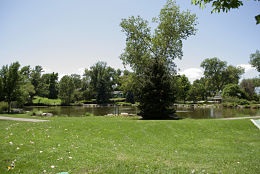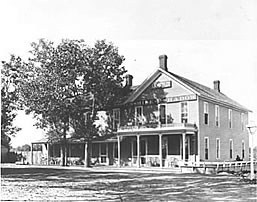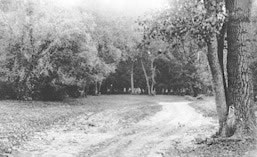Parks in Littleton
The public park movement in the United States dates from the 1850s, with the first great park being New York City's Central Park. Before this, and for many years after, most parks were privately owned, and use generally restricted to the upper class of society. Even Central Park, which was acquired and maintained with public moneys, was not really operated for the benefit of the masses. "Keep Off the Grass" signs meant just that -- stay on the paths, and recreations such as base ball were prohibited, but not cricket or horseback riding. Soon, though, the masses could not be restrained and the philosophy toward parks began to change.

Sterne Park, 2015. Photo by Amelia Martinez.
In Colorado, the first park in the normal sense of the word was Denver's City Park. When the land was purchased, it was prairie land a mile beyond the city limits. By 1880, with water supplied by the City Ditch, it was being transformed with lakes, trees, lawns and shrubbery, and recreational facilities such as a baseball diamond, horse race track, tennis courts and winter ice skating. Before City Park, Denver was blessed with a number of privately owned parks, most of which were open to the public.
The first park-like area in Littleton was the "field behind the mill" — that being the field between the South Platte River and the Rough & Ready Mill. As early as 1870, two years before the town was founded by Richard Little, there is mention of picnics and July 4th celebrations here. This was the tradition of early parks in the West, where some otherwise little-used area of some physical beauty, nearly always located next to a river, stream or lake, was made available for the public to use. For many years early Denver had such a place, too, described as the "grove at the foot of G Street".

Sunshine and Shadow Inn, c.1898.
The next popular location for outdoor recreation in Littleton were the grounds of the Sunshine and Shadow Inn, which was located on the west end of Main Street, facing the river. It had a large front lawn, which extended past the present-day Santa Fe Drive, and had a wide circular carriage road. The lawn had many large cottonwood trees which provided shade on hot, summer days. During the 1890s and 1900s, Littleton was a favorite "resort" spot for the citizens of Denver, who would either ride their bikes out along the City Ditch trail, or take the "Uncle Sam" train out for the day. The destination for many was the Sunshine and Shadow Inn, either to picnic and lay around among the trees, or to race their bicycles around the entrance drive.
Another privately owned area that was a favorite among locals in the 1920s and 1930s was "Bowles Grove" in the area just south of Bowles Avenue and west of the Platte. It was an area of dense woods, penetrated by a sole carriage trail and numerous walking paths. It was eventually purchased by the city and named Tramway Park.

Tramway Park, 1910.
Probably the most well-known park (in early days it was a dumping ground) in Littleton is the one between Main and Alamo Streets just west of the railroad "ditch". Originally this was called Rio Grande Park, because the land had been donated by that railroad. For many years before the opening of the Littleton History Museum, it was the repository of large pieces of Littleton history, such as the 1865 log schoolhouse and the Santa Fe railroad depot. These items were moved out and the park was rededicated as Bega Park, in honor of Littleton's Sister City in Australia.
In June, 1929, the Littleton Civic Commercial Association appropriated money to convert the John B. Mayers Lake on Bemis Street from a swamp into a park. A part of the old lake bed was dredged out and property was bought east of the lake running up to present Prescott Street. On the south end of the park land was donated to the City of Littleton by Edwin A. Bemis to become part of the park. In 1962 South Suburban Park and Recreation District acquired additional property extending the park to Lake Street. The late William C. Sterne contributed money for the development of this project and in order to show appreciation for what he had done for Littleton the park was named Sterne Park. Sterne Park has been used over the years for picnics and celebrations of various kinds.
In 1959, citizens in Littleton and southern areas of the metro area voted to create the South Suburban Park and Recreation District, which now operates parks in Littleton, Bow Mar, Columbine Valley, Sheridan, Lone Tree, the western portion of Centennial, and portions of Arapahoe and Douglas Counties. The District currently maintains thousands of acres of park land, miles of trails, an educational nature center, several recreation centers and a senior/community center. It offers a wide variety of cultural, fitness, sports and recreational programs, classes and activities for all ages.
Bibliography
Bemis, Edwin A. Historical Notes. Littleton, Colorado. Date unknown.
Littleton Museum. Photographic Archives.
____. Vertical File: "Parks".
Massengill, Patrick R. "An Ollapadrida of Exuberant Fun: Sports and Recreational Venues of 19th Century Denver". Denver: University of Colorado at Denver, 1997.
McQuarie, Robert J. and C.W. Buchholtz. Littleton, Colorado: Settlement to Centennial. Littleton: Littleton Historical Museum and Friends of the Library and Museum, 1990.
South Suburban Park and Recreation District. Annual Report, 1996. Englewood: South Suburban Park and Recreation District, 1996.
Photographs courtesy of the Littleton Museum, unless otherwise noted; to order copies, contact the Museum at 303-795-3950.
Compiled by Pat Massengill and Phyllis Larison
Updated May 2021 by Phyllis Larison